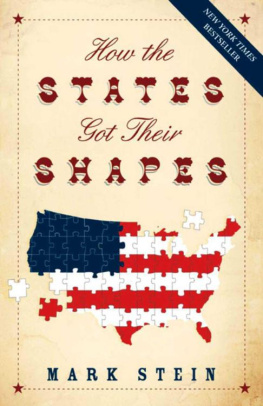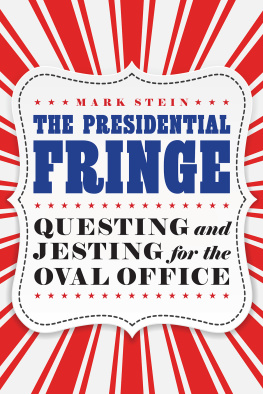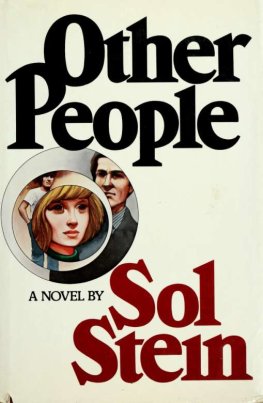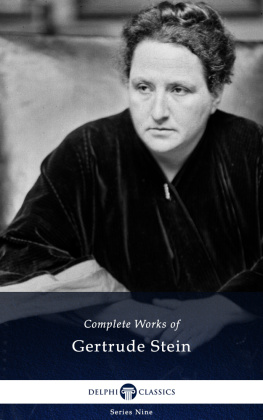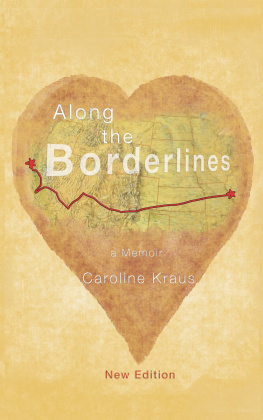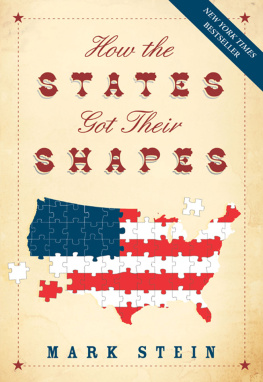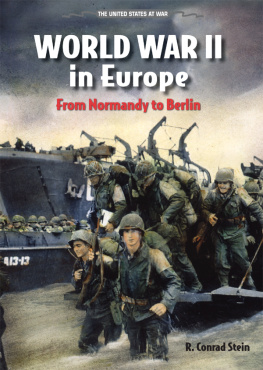Mark Stein - How the States Got Their Shapes Too: The People Behind the Borderlines
Here you can read online Mark Stein - How the States Got Their Shapes Too: The People Behind the Borderlines full text of the book (entire story) in english for free. Download pdf and epub, get meaning, cover and reviews about this ebook. year: 2011, publisher: Smithsonian Books, genre: Politics. Description of the work, (preface) as well as reviews are available. Best literature library LitArk.com created for fans of good reading and offers a wide selection of genres:
Romance novel
Science fiction
Adventure
Detective
Science
History
Home and family
Prose
Art
Politics
Computer
Non-fiction
Religion
Business
Children
Humor
Choose a favorite category and find really read worthwhile books. Enjoy immersion in the world of imagination, feel the emotions of the characters or learn something new for yourself, make an fascinating discovery.

- Book:How the States Got Their Shapes Too: The People Behind the Borderlines
- Author:
- Publisher:Smithsonian Books
- Genre:
- Year:2011
- Rating:3 / 5
- Favourites:Add to favourites
- Your mark:
- 60
- 1
- 2
- 3
- 4
- 5
How the States Got Their Shapes Too: The People Behind the Borderlines: summary, description and annotation
We offer to read an annotation, description, summary or preface (depends on what the author of the book "How the States Got Their Shapes Too: The People Behind the Borderlines" wrote himself). If you haven't found the necessary information about the book — write in the comments, we will try to find it.
Mark Stein: author's other books
Who wrote How the States Got Their Shapes Too: The People Behind the Borderlines? Find out the surname, the name of the author of the book and a list of all author's works by series.
How the States Got Their Shapes Too: The People Behind the Borderlines — read online for free the complete book (whole text) full work
Below is the text of the book, divided by pages. System saving the place of the last page read, allows you to conveniently read the book "How the States Got Their Shapes Too: The People Behind the Borderlines" online for free, without having to search again every time where you left off. Put a bookmark, and you can go to the page where you finished reading at any time.
Font size:
Interval:
Bookmark:

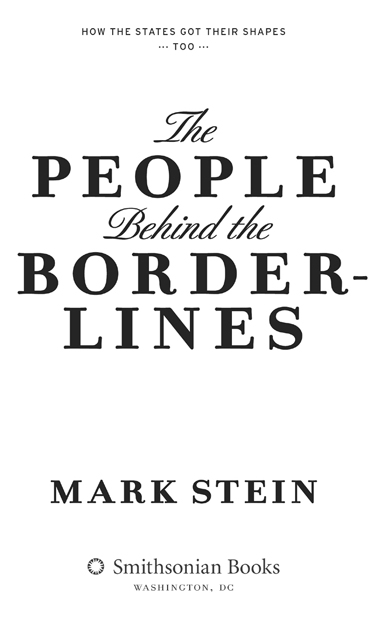
Text 2011 by Mark Stein
Cover illustration 2011 by Leigh Wells
All rights reserved. No part of this publication may be reproduced or transmitted in any form or by any means, electronic or mechanical, including photocopying, recording, or information storage or retrieval system, without permission in writing from the publishers.
Published by Smithsonian Books
Executive Editor: Carolyn Gleason
Production Editor: Christina Wiginton
Editor: Duke Johns
Designer: Mary Parsons
Maps: XNR Productions, Inc.
Photo Researcher: Amy Pastan
Library of Congress Cataloging-in-Publication Data
Stein, Mark, 1951
How the states got their shapes too : the people behind the borderlines / Mark Stein.
p. cm.
eISBN: 978-1-58834-315-4
1. United StatesBoundariesHistory. 2. U.S. statesBoundaries.
3. United StatesBiography. I. Title.
E180.S744 2011
973dc22
2011003467
For permission to reproduce illustrations appearing in this book, please correspond directly with the owners of the works, as seen on . Smithsonian Books does not retain reproduction rights for these images individually, or maintain a file of addresses for sources.
v3.1
N o child has ever been known to say, When I grow up, I want to establish a state line. But somebody had to do it. Who were those people? How did they end up in that endeavor?
As it turns out, the people involved in Americas states being shaped the way they are have come from all walks of life. Some are famous, such as Thomas Jefferson and John Quincy Adams, though how they participated in shaping our states is not widely known. Others are famous, but why theyre famous is not widely known. Daniel Webster, for example: is he famous because of his extraordinary debate in The Devil and Daniel Webster? Stephen Vincent Bents tale may well be why Webster remains famous. But Daniel Webster never debated with Satanat least not in public. He did, however, create one states lines.
Most of those who participated in the location of our state lines are not famous. Moreover, they are not exclusively white men. Women, African Americans, Native Americans, and Hispanics have also been involved in shaping the states.
For none of these people was the establishment of their state line their primary objective in life. Their participation in the creation of a boundary resulted from some personal quest. Those quests differed, yet each quest emanated from the issues of the time. Today those historical issues, and the personal quests they spawned, are imprinted on the map in the form of state lines.
The borders of the United States, however, do not fully enclose those quests. Many others sought, unsuccessfully, to create additional states in Canada, Mexico, Cuba, andstill an issuePuerto Rico. Their stories further enhance our perspective of the United States.
The American map is so familiar that even its straight lines begin to seem a part of nature. But looking at it through the individuals involved in its creation, that map becomes a mural. Its lines reflect an ongoing progression of Americans. Who, when, and where they were explains much of why we are who we are today.
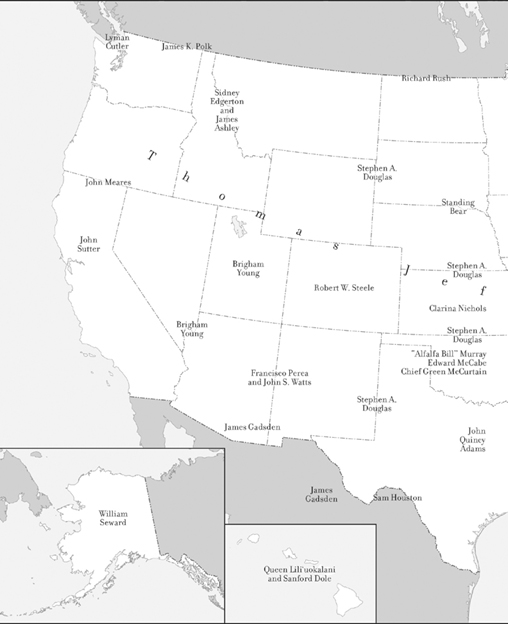
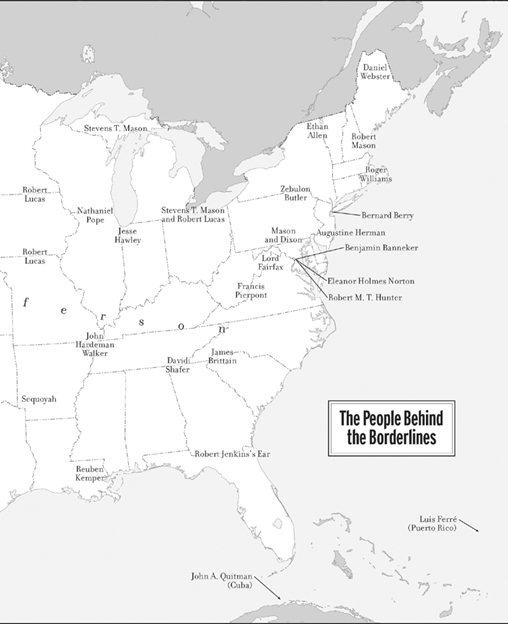
I was fortunate, after the publication of How the States Got Their Shapes, to be urged by my late and much missed editor, Caroline Newman, to offer a follow-up book. But having been a writer in theater and film, as opposed to nonfiction, I had difficulty framing an idea that fit the bill. So I called my longtime friend Mark Olshaker, author of several best-selling books, and asked if we could get together for lunch to see whether we could generate an idea. He said (and this is truly what he said), Sure. Next week is good. Or how about this? A book on the people, like that guy you mentioned in the first book with Missouri.
That is this book.
First and foremost, then, and with awe, I thank Mark Olshaker for an idea that, as it further developed, captured my imagination as much as my passion for maps drove me to write the first book. As it further developed refers in no small measure to the insights of Elisabeth Dyssegaard, who took over as my editor. Elisabeth did not have to fill Carolines shoes, because her own editor shoes fit beautifully. Too beautifully, since Elisabeth soon advanced to become editor-in-chief at another publisher. But her parting gift to me was an introduction to Kenneth Wright, who became my agent and navigated my now orphaned project in more ways than I can enumerate here, though I cannot leave unsaid the importance of the encouragement and clear thinking he provided. Ken succeeded in placing the book where I most hoped it would end up, at Smithsonian Books, copublisher of How the States Got Their Shapes, where I knew I would be in good hands with its director, and now my editor, Carolyn Gleason. I knew Carolyn was ideally suited because of an offhand remark she had made when we first met, shortly after How the States Got Their Shapes replaced my original title, Why Is Iowa? I liked your first title, she said, but it didnt work. I knew then we had the same sensibility, except she knew what worked.
Both my copy editor, Duke Johns, and the schoolteacher who taught him grammar and syntax deserve gold medals. Dukes mind is a lens of clarity. He is also an intimidatingly thorough fact-checker, for which I am extremely grateful. The treaties and legislation that created our state shapes are complicated and often overlap. To my astonishment, Duke dug them up, checking and adjusting my efforts to explain them. If any errors have slipped past him, it only shows that no goalie can block every shot. (He even nipped and tucked this paragraph.)
For the images in this book I was privileged to have Amy Pastan searching out photos and portraits with such enthusiasm that she discovered, and connected me with, a descendant of Jesse Hawley, the subject of one of the books chapters. Trudy Hawleys family records provided information not otherwise available. I was also delighted to be reunited with cartographer Rob McCaleb of XNR Productions, who had created the maps for my previous book. Once again he has turned words into maps that reduced me to one word: exactly. His geodetic eye also spotted an element in the battles fought by James Brittain that had gone unnoted by historians of North Carolina and Georgias violent boundary dispute, leading to its being noted for the first time in this book.
I also want to express my gratitude to the Bender Library at American University for the privileges it extended to me. And a special thanks to Professor William W. E. Slightsa profound influence on my life when I was his student at the University of Wisconsin, and a dear friend ever sincewho generously shared his knowledge of colonial era English abbreviations. I also received valuable assistance from Robert S. Davis Jr., Frank Drohan, and Paul Schmidt, in addition to Lauren Leeman of the State Historical Society of Missouri, Kari Schleher of the University of New Mexico Library, and Arlene Balkansky of the Serial and Government Publications Division of the Library of Congress. Ms. Balkansky, in addition to all her help with the resources of the Library of Congress, devoted time to reading each chapter as it was first drafted, spotting textual errors and even problems in the flow and arc of the draft. All of this not only exceeded the duties in her job description but also those in our wedding vows from over thirty years ago.
Font size:
Interval:
Bookmark:
Similar books «How the States Got Their Shapes Too: The People Behind the Borderlines»
Look at similar books to How the States Got Their Shapes Too: The People Behind the Borderlines. We have selected literature similar in name and meaning in the hope of providing readers with more options to find new, interesting, not yet read works.
Discussion, reviews of the book How the States Got Their Shapes Too: The People Behind the Borderlines and just readers' own opinions. Leave your comments, write what you think about the work, its meaning or the main characters. Specify what exactly you liked and what you didn't like, and why you think so.

